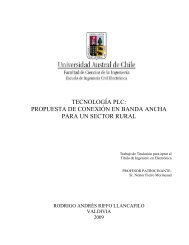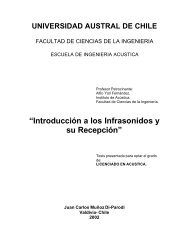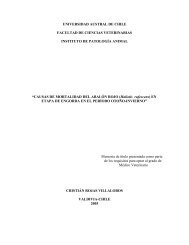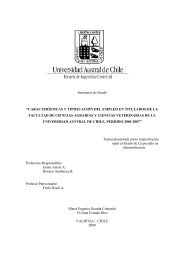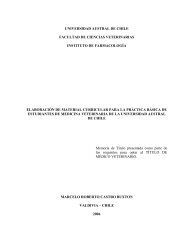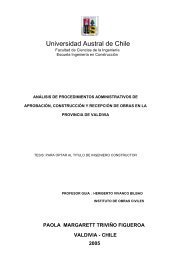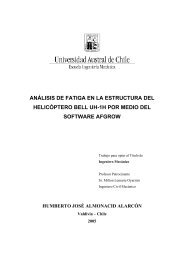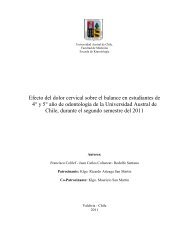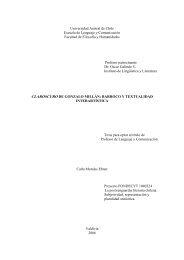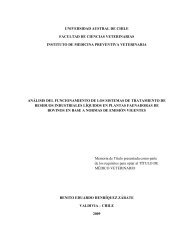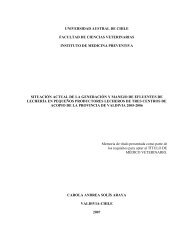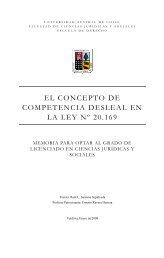Diversidad y control biológico de insectos - CyberTesis UACh ...
Diversidad y control biológico de insectos - CyberTesis UACh ...
Diversidad y control biológico de insectos - CyberTesis UACh ...
Create successful ePaper yourself
Turn your PDF publications into a flip-book with our unique Google optimized e-Paper software.
centrifugation and supernatant was discar<strong>de</strong>d, 1 mL ethanol wash buffer was ad<strong>de</strong>d, glass<br />
pow<strong>de</strong>r was suspend with a pipet tip and glass pow<strong>de</strong>r was centrifugated again with a brief<br />
centrifugation. Ethanol was discar<strong>de</strong>d and tubes were dried on a heat block (55 ºC, 10 min).<br />
Glass pow<strong>de</strong>r was suspen<strong>de</strong>d in sterile distilled water (100 µL) and heated for 1 min (55<br />
ºC). Finally, glass pow<strong>de</strong>r was packed and eluted DNA was transferred to a clean tube and<br />
stored at -20º C. Aliquots were used to check DNA quantity and quality.<br />
Amplification and sequencing.<br />
DNA sequences from the B fragment were obtained by cycle sequencing of PCR-amplified<br />
DNA. PCR reactions were performed in 50 µL final volume containing 2 µL template<br />
DNA, 5 µL of 10X PCR buffer (10 mM Tris/HCl pH 8.0, 50 mM KCl, 1.5-2.0 mM<br />
MgCl2), 4 µL of dNTP mix (1.25 mM each dATP, dCTP, dGTP, and dTTP), 10 pmol each<br />
of the opposing amplification primers, 0.5 µL Taq polymerase (Promega, Madison, WI).<br />
The reactions were run in a MJ Research PTC-200 thermocycler, using a touchdown PCR<br />
procedure (Rehner and Buckley, 2005). Primers B5.1 and B3.1R were used for spanning B<br />
fragment (Table 3).<br />
Before to separate the PCR products by electrophoresis, the PCR volumes were reduced in<br />
a Speed-Vac (2 h, highest <strong>de</strong>siccation rate). Remnant volume was eliminated with a brief<br />
spin. DNA was resuspen<strong>de</strong>d in 1X low EDTA (0.1 mM) TAE electrophoresis buffer to<br />
which has been ad<strong>de</strong>d 1/10 volume loading buffer. PCR products were loa<strong>de</strong>d onto 1.5%<br />
NuSieve agarose gels (Bio-Whitakker, Rockland, Maine), stained with ethidium bromi<strong>de</strong>.<br />
After the run, the gel was cooled (15 min, 5 ºC). The amplicons were visualized by<br />
exposing the gel to UV light and excised using a broad-nosed scalpel bla<strong>de</strong>. Gel slices were<br />
frozen (-20 ºC) until sequencing. At this point, gel slices were thawed and centrifuged in a<br />
microcentrifuge (20000 x g, 10 min) to compress the gel slice and extru<strong>de</strong>s DNA.<br />
The sequencing reactions were performed with ABI BigDye 2.0 (Applied Systems, Foster<br />
City, CA) with a total volume of 5 µl, which inclu<strong>de</strong>d 0.5 µl BigDye diluted in 1,5 µl<br />
dilution buffer, 3 pmol primer, 100 ng gel-purified PCR template. Cycle sequencing was<br />
performed in 96-well microtiter plates according to the manufacturer’s instructions. The<br />
22



